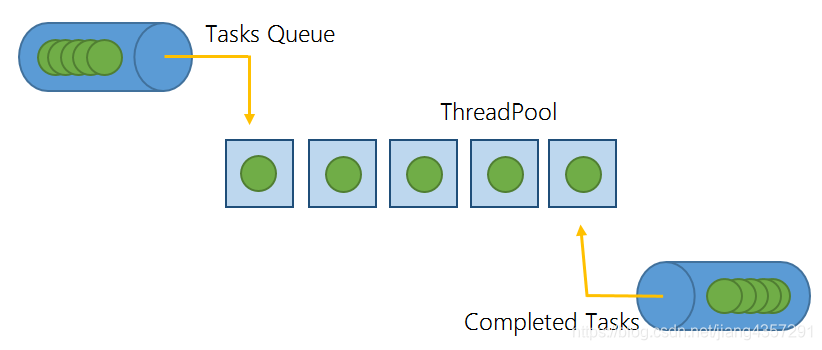前端时间偶然在github上看到了一个非常精炼的 C++11线程池实现。作者用不到100行的代码实现了一个简单的线程池,且使用了较多C++11的新特性。于是便想着自己也来动手看看,思路上基本是借鉴原版,但会加入一些自己的想法和尝试,同时先避免对复杂语法的运用以理解线程池为首要目的。由于个人能力有限,如果代码中有明显bug欢迎指正,一起交流进步。
线程池基本组成
在贴源码之前先介绍一下线程池的基本组成,线程池一般由两种角色构成:多个工作线程和一个阻塞队列。
- 工作线程
工作线程是一组已经处在运行中的线程,它们不断地向阻塞队列中领取任务执行。 - 阻塞队列
阻塞队列用于存储工作线程来不及处理的任务。当工作线程都在执行任务时,到来的新任务就只能暂时在阻塞队列中存储。
一张图片便可以很直观的展示线程池:

源码和分析
ThreadPool.h:
#ifndef _THREAD_POOL_H
#define _THREAD_POOL_H
#include <vector>
#include <thread>
#include <mutex>
#include <functional>
#include <queue>
#include <future>
#include <memory>
#include <condition_variable>
class ThreadPool
{
using Task = std::function<void()>;
public:
ThreadPool(size_t num);
~ThreadPool();
void entry();
void shutdown();
template <class Function,class... Args>
// add_task相当于是对一个通用函数包装器的改造,不同点在于通用包装器的返回值可以return,而这里添加的task还未被执行
// 需要等到将来工作线程来取,因此其返回类型的实现就需要用到std::future和std::packaged_task
auto add_task(Function &&f, Args&&... args) -> std::future<decltype(f(std::forward<Args>(args)...))>
{
using return_type = decltype(f(std::forward<Args>(args)...));
// 通过std::bind()构造出一个void()可调用对象
auto fun = std::bind(std::forward<Function>(f), std::forward<Args>(args)...);
// 通过packaged_task获取一个异步操作的返回值,返回值也就是fun()也就是f(std::forward<Args>(args)...)的返回值
auto task = std::make_shared<std::packaged_task<return_type()>>(fun);
auto res = task->get_future();
{
std::unique_lock<std::mutex> lock(task_mutex);
tasks.emplace([task]{(*task)();});
}
cond.notify_one();
return res;
}
private:
std::vector<std::thread> threads;
std::condition_variable cond;
bool stop;
std::queue<Task> tasks;// task排队应该先进先出,所以用队列
std::mutex task_mutex;
};
#endif
ThreadPool.cc:
#include <iostream>
#include "ThreadPool.h"
using namespace std;
ThreadPool::ThreadPool(size_t num):stop(false)
{
for(int i=0;i<num;++i)
threads.emplace_back(&ThreadPool::entry,this);
}
void ThreadPool::entry()
{
while(1)
{
unique_lock<mutex> lock(task_mutex);
// 当任务队列为空且线程池正常状态时才会阻塞,被唤醒可能是由于有新任务到来或者是线程池准备停止
cond.wait(lock,[this]{return this->stop||!this->tasks.empty();});
// 如果是线程池停止,则退出子线程
if(stop)
return;
// 否则就从任务队列中取最靠前的一个任务进行执行,并将任务出队
Task cur_task = std::move(tasks.front());
tasks.pop();
lock.unlock();// task取出后就可以解锁
cur_task();
}
}
ThreadPool::~ThreadPool()
{
cout<<"delete pool!"<<endl;
if(!stop)
shutdown();
}
void ThreadPool::shutdown()
{
// 修改stop为true并通知所有线程池中的线程
{
unique_lock<mutex> lock(task_mutex);
stop = true;
}
cond.notify_all();
// 同时等待子线程执行完成
for(auto &th: threads)
th.join();
}
测试代码
main.cc:
#include <iostream>
#include <chrono>
#include "ThreadPool.h"
using namespace std;
int main()
{
ThreadPool pool(4);
std::vector< std::future<int> > results;
for(int i = 0; i < 8; ++i) {
results.emplace_back(// std::future不能复制,所以这里必须用emplace_back原地构造
pool.add_task([i] {
std::cout << "hello " << i << std::endl;
std::this_thread::sleep_for(std::chrono::seconds(1));
std::cout << "world " << i << std::endl;
return i*i;
})
);
}
for(auto && result: results)
std::cout << result.get() << ' ';
// .get()会阻塞直到获取到结果,如果shutdown放到get之前则get会一直阻塞
pool.shutdown();
std::cout << std::endl;
return 0;
}
其中的一些关键点分析:
- 基本工作流程:线程池构造函数时创建n个线程,此时任务队列为空,所以这些线程都在阻塞状态,等到往任务队列中添加task,工作线程则取走task并执行。
- 线程池的退出由用户控制,提供了stop接口供用户停止,停止线程时会等待正在执行task的工作线程执行完成再回收。
- 代码的主要实现就是entry()和add_task(),前者实现了等待取task的逻辑,后者实现了异步执行task且支持各种类型的函数形式。其中关于add_task(),如注释所说相当于是对一个通用函数包装器的改造,不同点在于通用包装器的返回值可以return,而这里添加的task还未被执行需要等到将来工作线程来取。
- 注意std::future是不能拷贝的,所以如果要放到vector中必须原地构造
先来看一下通用函数包装器的实现:
template <class Function,class... Args>
auto GeneralFunWrapper(Function &&f, Args&&... args) -> decltype(f(std::forward<Args>(args)...))
{
return f(std::forward<Args>(args)...);
}
或者换一种实现方式,虽然就包装器来说多此一举但是对于向add_task的转化就更直观:
template <class Function,class... Args>
auto GeneralFunWrapper(Function &&f, Args&&... args) -> decltype(f(std::forward<Args>(args)...))
{
auto fun = std::bind(std::forward<Function>(f),std::forward<Args>(args)...);
return fun();
}
针对以上代码做基础修改:
- 返回类型改为future
- 需要将Function类型再封装为void()形式以适配Task
- 直接执行改为放入task队列
- 加入队列后唤醒线程池中的一个线程
参考
[1] A simple C++ 11 Thread Pool implementation
[2] 《深入应用C++ 11》by 祈宇





















 929
929











 被折叠的 条评论
为什么被折叠?
被折叠的 条评论
为什么被折叠?








